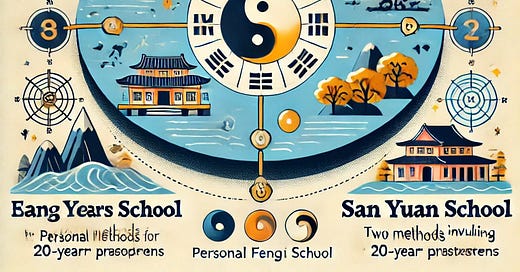Feng Shui Schools & Sects in a Nutshell
San He? San Yuan? Xuan Kong? 8 Mansion? What the.....🤯🤯🤯
The Big Two
Form School (形勢派) is a traditional method that focuses on the shape of the land. It emphasizes the importance of observing mountains, water, and the arrangement of surrounding buildings. Having a mountain behind your home provides a sense of security, acting as a strong backing, which contributes to stability in your life or business. Similarly, having a river or road in front is crucial, as it promotes a favorable flow of energy (chi). When your house is situated in a location with good landform, you can enjoy lasting good fortune and harmony, potentially benefiting for generations. However, if significant developments occur or if trees in the vicinity are removed, the feng shui of the area may change.
Formula School (理氣派) is divided into two primary methods. One focuses on the Qi connection between the Qi source and the focal point or spot, while the other focuses on Qi mapping within a confined space made up of at least three walls and a roof.
The Permutation Heavyweights
In general there are a few schools that is use predominant to measure external landforms like mountain and river & below we introduce 3 of these formula-based “heavyweights”.
San He School (三合派) emphasizes the relationship between mountains, water, and homes. It is particularly effective in identifying optimal locations for residences or burial sites. Ideally, a house should have a mountain behind it for support and water in front for prosperity. This type of feng shui is quite robust since the positions of mountains and water do not change easily. If you purchase a house situated in a favorable San He location, the positive effects can be long-lasting, potentially influencing the fortunes of future generations. San He goes hand in hand with Form School.
San Yuan School (三元派) places heavy emphasis on the correlation between time and space. It is based on the mechanism of 數氣象, which governs Qi connection, timeliness, and the imagery of events. Generally, there are two major calculations: 2 Cycles 8 Periods (兩元八運), divided into Upper and Lower Cycles, with each governing 90 years; and 3 Cycles 9 Periods (三元九運), divided into Upper, Middle, and Lower Cycles, each governing 60 years. Both methods form a complete cycle spanning 180 years.
Xuan Kong Da Gua (玄空大卦) is a highly advanced method designed for master-level practitioners. It is the predominant Qi connection method within the San Yuan Fraternity. It uses the 2 Cycles 8 Periods San Yuan timeliness system. It requires precise calculations of direction and timing based on cosmic energy. To effectively use this method, accuracy is essential, including the degree of your house and the exact timing of significant activities, such as renovations or ceremonies. When executed properly, it can provide substantial long-term benefits. However, practitioners must also monitor time cycles and make occasional adjustments, giving it a mid-term aspect. Some experts regard it as one of the most powerful feng shui practices when applied correctly.
Within 4 or Some Say 3 Walls & a Roof
When we regulate Qi within a fixed enclosure as in the internal of a house, the Feng Shui term is call Qi mapping. Internal Feng Shui is all about how you tap the external Qi from the main door and “Rides the Sheng Qi” throughout the 4 corners within the house.
In regards to Qi mapping, we have two predominant schools, one perceived to be long-term and the other time-based:
The first is the Eight Mansions (八宅), which is based on either the 命卦 (Life Gua) or 宅卦 (House Gua) number, derived from your birth year or house sitting. Understanding your Gua allows you to identify directions and locations that are favorable for various aspects of your life, including health, career, relationships, and wealth. For instance, if your lucky direction is southeast, it is advisable to sleep or work facing that way to enhance positive outcomes. Since your Gua number remains constant, this type of feng shui can have a lasting effect unless you relocate, in which case adjustments will be necessary.
The second method is Flying Stars (飛星), which is quite popular and favored by many practitioners due to its accuracy. It is based on the 3 Cycles 9 Periods San Yuan timeliness system. Each house has a unique flying star chart that changes over time. Every year, specific stars shift to different areas of the house, influencing good or bad energy. For example, one year, the wealth star might occupy your kitchen, and you could enhance this by placing water-related items there. However, the following year, the star might move to your bedroom, requiring a rearrangement of items. This method also operates on 20-year cycles, meaning a major feng shui adjustment is needed after two decades. Hence, it is considered mid-term, as conditions are always evolving.
In summary, if you are seeking long-lasting effects, the Form School, Eight Mansions and San He are excellent choices, particularly when practiced correctly. For mid-term effects, the Flying Stars, Xuan Kong Da Gua and San Yuan methods are suitable, as they change over time and require periodic adjustments. Depending on your goals, some feng shui schools can provide enduring, solid results, while others are better suited for short-term improvements.
Do help LIKE & SHARE this if you find it helpful so that it can help many more as well.
If you have any doubts and queries feel free to leave a COMMENT and I will get back to you.
Cheers 🍷




